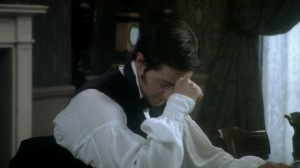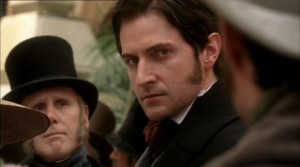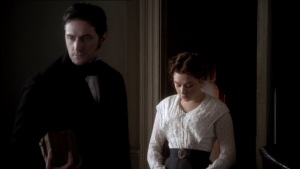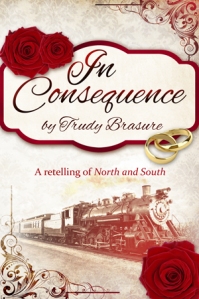This is the second day when I’m fortunate enough to welcome North & South continuation writer Trudy Brasure, author of A Heart for Milton and In Consequence.
You can check out Trudy’s previous post here.
I hope you all did your homework from yesterday and have thoroughly researched the answers to the quiz questions!
You can also get your hands on Trudy’s latest book In Consequence which is a corker, so check out the giveaway info 🙂
and now, here are ….
Trudy’s PET PEEVES regarding North and South
(John withers away insipid comments with one penetrating stare…)
Mind you, I’m aware that my passion for my favorite book/film can get rather geeky and intense. But I’ve spent the last four years thinking about and discussing Gaskell’s story and characters. Forgive me.
#1 The constant comparison of Gaskell to Austen and North and South to Pride and Prejudice. Must every story with a failed proposal set in the horse and buggy days hearken us back to Austen’s patented plot? Couldn’t we look at Gaskell’s merits as a writer based on her own style and subject material? Austen and Gaskell aren’t even from the same era for crying out loud! Bronte and Dickens seem more likely comparisons for the passion and social issues dealt with in North and South. I know this annoying occurrence will never cease in my lifetime but …Grrr!
#2 The half-knowledge behind the oft-repeated fact that Gaskell was rushed to finish her ending. Yes, Dickens forced her to hurry her story’s conclusion during the serial publication of N&S in his magazine. It’s a tasty tidbit of history that sticks in the mind. Poor Gaskell – that mean ol’ Dickens! However, what many don’t realize or remember is that Gaskell went back to add two whole chapters and embellish other sections of North and South before it was published as a book. She left that end scene alone. Hmm…. ( psst! I loved the ending in the book! for more about Gaskell’s ending see my post at WestofMilton here: LINK)
#3 That PBS/Masterpiece missed airing North and South in the US. Will we ever know the mystery behind this omission? I’ve heard a few theories, but I’ll never get over this disservice to the American public. If PBS is meant to bring fine art to the masses, they certainly missed sharing one of the BBC’s finest period dramas…. and the best kiss scene ever recorded on film.
#4 Interpretations of John and Margaret based solely on the first half of the book/story. I have to wonder if some people really saw/read the whole thing. Granted that the first half is all spitfire and clashing, but the second half in which each learns to deeply consider the other’s perspective is beautifully, if more subtly, drawn. I can’t fathom that Gaskell intended her characters to stay the same throughout the arc of the story. So pardon me if I disagree wholeheartedly with those that believe that Margaret and John would be forever clashing on ideology and social morality. Where’s the proof of that in the unfolding events, actions, and words of the second half?
Does this look a girl who still holds grievances about the Master’s character and business practices?
#5 The lousy introduction to the book in the Penguin edition. This almost ruined my appetite for reading the book the first time around. With a heavy emphasis on sexual symbolism and the power struggle between male and female positions, this analysis of Gaskell’s work sapped most of the deeper meaning out of the story and highlighted the dry, intellectual wrestlings that academics feed upon. I’d like to have it out with Patricia Ingham, Ph. D. on a few of the aspects concerning John and Margaret’s relationship that I feel she interpreted completely wrong.
BOOK GIVEAWAY!
Don’t forget to leave a comment for a chance to win a copy of In Consequence! The winner will be announced next Thursday.
Now’s the perfect chance to chat with me, ask me something, or (gasp!) disagree with my interpretation of the story and characters. I’d love to hear from you.
Quiz Answers:
1.) Margaret is 18 in the opening scene of the book.
2.) The Lennox family is from Scotland.
3.) Anna Beresford married General Shaw.  damn! missed that one!
damn! missed that one!
4.) Adam Bell.
5.) Bessy
6.) Helstone is not too far from Southampton. It’s mentioned that Mr. Hale walked there once from the vicarage.
7.) George Leonards (from Southampton) had a job as a railway porter at the time of the incident.
8.) Maria and Richard Hale.
9.) False. It’s not possible to draw an accurate calendar of the events as they are indicated in the book. The Thornton dinner is on the 21st of July, yet Gaskell has Margaret going to Marlborough Mills for the water mattress three days later under “an August sun.” Frederick also arrives much too early on the scene after Margaret has written for him. (Where was the Dickens’ editing hand here I wonder. lol.)
10.) Aunt Shaw had a lap dog named Tiny.
11.) Frederick married Delores Barbour.
12.) Hannah reads from the Bible every night to the household. She tries to read from Matthew Henry’s Commentaries as she awaits John’s return from the proposal.
13.) Hannah remembers “a little daughter – dead in infancy.”
14.) False. The Great Exhibition is never mentioned in Gaskell’s work.
15.) True. In the book, Mr. Thornton learns that Margaret has a brother from Mr. Bell.
16.) True. Higgins calls Thornton a bulldog in the book as well.
17.) Thornton saw Helstone on his return from Le Havre.
18.) True. John attends both Mrs. and Mr. Hale’s funerals without Margaret knowing he has done so.
19.) Mr. Colthurst is a the vaunted guest at the dinner party in London.
20.) d. It has been two years of struggle and heartache since John first declared his love the day after the riot and that private meeting sans Henry in Aunt Shaw’s back drawing room.
How’d you do? Thanks for joining in the fun!
The Book Giveaway is now finished!













Great post. I certainly agree that comparisons with Pride and Prejudice are wrong-headed. Yes, both stories have a battle of the sexes, but Gaskell has a completely different sensibility and belongs two generations later.
Thanks for commenting. I’m amazed at how many people at Goodreads have mentioned Austen as a favorite Victorian author. ???! Austen died before Queen Victoria was even born.
They probably think Downtown Abbey is “Victorian” too!!
😛 I hate to think of it!
I think both writers should take pride in their work. It bothers me when people show prejudice against one or the other. It makes no sense and their sensibility in the matter can boggle the mind. I guess it depends on whether or not your wives and daughters were from the North and South. I remember talking to my Aunt Ruth and cousin Emma about this very thing.
Can Trudy pick out all the books I’ve listed?
I’ve read Pride & Prejudice (but prefer Persuasion, which you didn’t mention.) I’ve seen but not read Sense & Sensibility and Emma (Emma is not a favorite of mine). I absolutely loved Gaskell’s Wives & Daughters, which I read this summer. Her novel Ruth is next on my reading list. I’ve also read Gaskell’s Mary Barton, which the BBC is reportedly making into film.
Very clever, btw. 😉
LOL. Enjoyed reading these a lot. re: 4, you already know how I feel about the potential success of their relationship, so I’ll spare us a rehash of that discussion, but I had to laugh when you were grousing about the Penguin.
I *always* *always* buy/assign the Norton over the Penguin for classroom purposes. This is a matter of no little contention among history professors. *English* professors tend to like the Norton, because they always include the 2-3 most important critical essays on the work. History professors like the Norton b/c of the supplementary contextualizing sources that are always included, but we tend to prefer the cheaper book, which is almost always the Penguin (although Penguin is now being undercut by other publishers, which is mostly a good thing IMO) since we usually contextualize in the classroom. (Also Penguin’s corporate structure means they are a bit more generous w/review copies [Norton is employee owned and very frugal] and I have a lot of TAs and it run into money if I have to buy their books for them every term, so there’s an incentive for Penguin there.) I have had so many bad experiences with the Penguin introductions because they tend to “give away” or pronounce on issues I’d like the students to develop and ponder themselves. E.g., the Penguing of de las Casas “Short Account of the Destruction of the New Indies” tells you that he was lying about some of the material in there. If you read it, you figure that out yourself and come to your own opinion about why he did it and what purpose it serves, but the Penguin introducer gives that away and then tells the students how they should feel about it. So no more Penguins for me in the classroom, and if I have to read something in the Penguin edition for some reason for myself, I read the introduction to the Penguin after I’ve read the work.
I’d be the first to say it’s totally possible, even as an academic, to write an introduction to a book that doesn’t give away all the discussion points (I’ve done it myself) but the Penguin authors seem to be told by the publisher to attempt to write a definitive essay about the work. I don’t need my students to see that ahead of time. I usually tell them not to read the introduction first but there will always be a few that will do that.
Now, however, based on what you’ve said about Ingham’s introduction — I’m *dying* to find out what she said about the gender power issues in the work! When I finish this comment I’m going to rush over to amazon and look for a copy 🙂 I’m sure that wasn’t your intent, but most of the criticism I’ve read of N&S has — as you note — either missed the point in some fruitless comparison with Jane Austen — or been rather insipid. This sounds like it’s not at all! Can’t wait.
(I do own the Norton and I especially like the cover illustration. LOL.)
That’s so interesting. Now I must dash to get the Norton edition! (But from where?)
I didn’t mind the spoilers so much, having seen the mini-series first before reading the book, but I don’t care to be told what to make of things so bluntly before getting the chance to read it myself and form my own ideas of what’s going on.
In contrast, I enjoyed the introduction in the (pink) Barnes & Noble edition of Wives & Daughters so much I emailed Amy King, Ph.D. to tell her. Her introduction enhanced my reading by preparing me for the pace and setting and giving some insights into what to look for in the book. It did what an introduction should do – it enhanced my enjoyment of the book.
And now that I know a good introduction is possible, it makes the Penguin one so much the worse!
It’s still in print, isn’t it? You could get it from the WWNorton website or from amazon, I assume. I don’t think they do Kindle.
Fwiw, this isn’t IMO about having a PhD or being an academic. Usually there’s a charge from the publisher to the author of something like that. One is told the level of argumentation, the envisioned audience, the purpose of the essay, the extent to which it should try to cover familiar themes vs breaking new ground, etc. If Ingham was told to write a traditional academic essay on the topic, she needed to provide a strong argument based on the topics of latest interest in the field at large. That’s what academics do; that’s what we teach our students how to do. She probably had an incentive to do it also in terms of promotion and raises, depending on where she works. B&N possibly sees its readership as different and thus asks the author of the introduction to do something different in the essay.
I won’t hold the type of introduction against Ingham if it was out of her control….but she still got things ‘wrong.’ lol!
I’m trying to figure out how to buy it — it looks like that ed. w/Ingham’s intro is out of print. Not sure I want to pay $20 for a paperback. Will look for it in the lib and get back to you.
I’m pretty sure it’s the edition Amazon readily sells. It says ‘introduction by Patricia Ingham…’
oh, wait I found one. OK. Ordering 🙂
yeah, I figured it out eventually. I was confused by the fact that if you click on the Kindle link in that entry it takes you to a different edition and so does one of the pb links I saw. Also not clear that the new Penguin still has the Ingham intro or if I have to get the old one (got the old one to be safe, too lazy to check ISBNs).
Pingback: A favorite North & South scene that Richard Armitage isn’t in — can you believe it? | Me + Richard Armitage
Trudy, I failed miserably at the quiz. There were maybe 2 or 3 I got right and I’ve actually read the book (OK, I may have skipped a few paragraphs to get to the good parts…meaning Thornton…). A lot of the info you included in the quiz helps to understand the TV adaptation, for example how John “Sexy Cravat” Thornton ended up on Helston of all places. It would also stand to reason he’d attend Mr Hale’s funeral.
I didn’t really expect many fans to do well on the quiz. I thought it would be fun to share some of these lesser known facts, though. 🙂
Lol. I confess I was also a little impatient to get to the ‘Thornton parts’ of the book the first time I read it! The beginning is all Margaret, Margaret. And if you’re coming straight from the mini-series you’re bound to be eager to have Thornton on the scene. But “Margaret Hale” was Gaskell’s original title for the book. That speaks volumes, I think. We’re supposed to experience most of the story through her eyes.
John is such a devoted man to those he really cares about! According to the book, when John sweeps into the drawing room of his home just in time to hear Margaret say her goodbyes, he’s just come back from attending the funeral at Oxford. She doesn’t even know that. He’s amazing.
Thanks so much for the privilege of posting as a guest on your blog.
I did not do very well considering how many times I have read and watched N & S. I got 7 right out of 20 which is about 35%. I’d be failing if this was a true test.
I look forward to reading your work Trudy. I haven’t come across it before now but I will definitely follow up.
I made the quiz hard on purpose. 7 is good! Some of these facts I picked up on my second read, others are details I’ve come to know easily as I write my own version of events with Gaskell’s facts. Thanks for your interest in my stories. I hope you’ll enjoy them. 🙂
I am loving these guest posts, Trudy! You had me stumped on some of the questions..as the book and movie and all the fan fic I’ve read starts to get jumbled up in my mind. I absolutely agree with number 1 pet peeve. I love the fact that N&S is set in Victorian England and deals with class and working conditions. It is probably because Thornton is among the working class that I can say Thornton is greater than Darcy. Sigh–wish I had that t-shirt:)
Yes, I’d love that as a bumper sticker! Thornton > Darcy. It’s one of my life missions to make N&S better known in the States. Everyone’s already heard of P&P. 😉
I love both stories but to be truthful I really loved N&S more because there is so much more sensuality to it and in the end there is that wonderful train station scene. Different time periods certainly and they shouldn’t really try and compare the two books if not just for that reason. We could go into the whole pride thing here but the tales really are different and should be viewed as such. N&S does touch on the culture itself of the time but there is so much more there to say about how business was run and unions. Given her age Margaret was certainly ahead of her time but I think that the two of them would have enjoyed each other so much more because of the differences they had and certainly they would not have continued the discord we saw at the beginning. John learned a great deal from Margaret and Margaret certainly learned more about John and the business of cotton. In a sense this story is so much more well rounded. It isn’t just about marriage and family which in many ways Pride and Prejudice was. North and South is a wonderful story and stands on its own as such.
I read somewhere that Austen herself categorized P&P as a ‘light’ story. Can’t say that about N&S! I like Gaskell’s story for so many reasons, but the passion and the inclusion of the working class in her perspectives make it really different from Austen’s work. Gaskell is musing on the role of capitalism in modern society. It’s still a very relevant consideration today – and a very serious one.
My weakest points on your quiz were mostly the names, including the dog. I’d forgotten that the scene where Thornton enters the parlor coming back from her father’s funeral was so close to the the scene in the series. But I’m thinking Hannah mentioned to them that John was not there because he’d gone to Oxford for the funeral. Then he suddenly shows up kind of flustered. What occurs next is probably my favorite scene in the film.
The lap dog was my meanest question! Lol. Way too trivial for most people to notice.
Yes, that goodbye scene is more potent than the riot scene – at least it is in the mini-series. That’s the scene I had to reinvent – that began my entire writing career!
Pingback: Armitage Weekly Round-Up Week 5 | I Want to be a Pin Up